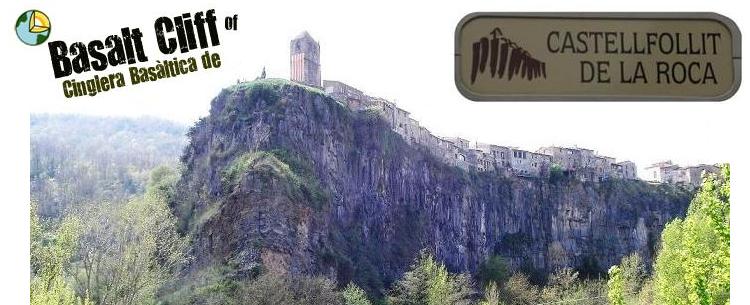
The village of Castellfollit de la Roca, is a natural viewpoint.
Located at the north-east of the Garrotxa Volcanic Zone Natural Park. Among the stream of Turonell (south) and Fluvià River (north). It locates in the natural boundary between the Baixa Garrotxa (relief softer and more fertile valleys and wet), and the Alta Garrotxa (rugged relief, due to the limestone that is dominated). Along the precipice, there is a row of houses, many of which natural erosion, has dropped the backyards and in some other part of the building.
Should be admired from the road, the basalt cliffs, and climb to the village to explore the medieval alleyways, of old town. The houses, mostly built with volcanic rock, have a special charm. From the viewpoint-square Josep Pla, you can see the patchwork of farms scattered among the valleys of two rivers and the landscape that stretches beyond. If you climb the bell tower of the Church of San Salvador, the effect is even more impressive. The temple became a cultural center, is the thirteenth century.
El poble de Castellfollit de la Roca, és un mirador natural.
Està situat a l’extrem nord-est del Parc Natural de la Zona Volcànica de la Garrotxa, entre la riera del Turonell al sud, i el riu Fluvià al nord. Es localitza en el límit natural entre la Baixa Garrotxa, de relleu mes suau i valls més fèrtils i humides, i l’Alta Garrotxa de relleu abrupte a causa de les roques calcàries que hi predominen. Arran del precipici s'hi assenta una filera d'habitatges, molts dels quals l'erosió natural ha fet desprendre els patis posteriors i d'altres alguna part de l'edifici.
Cal admirar la cinglera basàltica des de la carretera i pujar fins al poble, per recórrer els carrerons del barri antic. El seu origen medieval els fa estrets i foscos. Les cases, construïdes majoritàriament amb pedra volcànica, tenen un encant especial. Des de la plaça-mirador Josep Pla es pot observar el mosaic d'hortes disseminades entre les valls dels dos rius, i el paisatge que s'estén més enllà. Si puges al campanar de l'Església de Sant Salvador, de planta quadrada i oberta als quatre vents, l'efecte és encara més impressionant. El temple, convertit en centre cultural, és del segle XIII.

The most significant geological feature of the Garrotxa Volcanic Zone Natural Park, is defined by volcanism, which from various events during the Quaternary era, has left imprints features in the landscape shaped by volcanic cones, lava flows, and valleys plains. Garrotxa volcanic materials, are of basic nature (poor in silica) and correspond to basalts and basanites very massive, forming lava flows, which occupy the plateaus and can be found stationed in the river beds or their margins , and pyroclasts, forming the volcanic cones.
El tret geològic més significatiu del Parc Natural de la Zona Volcànica de la Garrotxa, ve definit pel vulcanisme que, a partir de diverses manifestacions al llarg de l’era Quaternària, ha deixat característiques empremtes en el modelat del paisatge a través de cons volcànics, colades de lava i valls planeres. Els materials volcànics de la Garrotxa són de naturalesa bàsica (pobres en sílice) i corresponen a: basalts i basanites molt massives, que formen les colades de lava, que ocupen els altiplans i es poden trobar emplaçades en els llits fluvials o als seus marges, i els piroclastos (cendres, gredes, escòries i blocs), que conformen els cons volcànics.
GEOLOGICAL INTEREST OF CASTELLFOLLIT DE LA ROCA INTERÈS GEOLÒGIC DE CASTELLFOLLIT DE LA ROCA
The high interest of this town lies in the exceptional landscape of the outcrop, and in the area allows the observation of different geological processes associated with volcanism: overlapping lava flows, instabilities of basalt cliffs, and erosion processes (river erosion). With the added value of being a cliff 50 meters, with the people of Castellfollit, in the top.
It is the most spectacular example of basalt flow, with prismatic morphologies, in Catalonia and Spain. This outcrop can not be considered unique, since in the same volcanic area of Garrotxa, this outcrop can not be considered unique, since in the same volcanic area of Garrotxa, there are other cliffs, which can illustrate the same processes, but Castellfollit is characterized by easy access and good observation.
L’elevat interès d’aquesta localitat rau en l’excepcionalitat paisatgística de l’aflorament i en que la zona permet l’observació de diferents processos geològics relacionats amb el vulcanisme: superposició de colades de lava, inestabilitats de cingleres basàltiques i processos erosius (erosió fluvial). Amb el valor afegit de ésser una cinglera de 50 metres amb el poble de Castellfollit al damunt.
Constitueix l’exemple més espectacular de colada basàltica amb morfologies prismàtiques de Catalunya i de la Península Ibèrica. Aquest aflorament no es pot considerar únic ja que en la mateixa zona volcànica de la Garrotxa, existeixen altres cingleres que permeten il·lustrar els mateixos processos, però Castellfollit destaca pel fàcil accés i la bona observació.
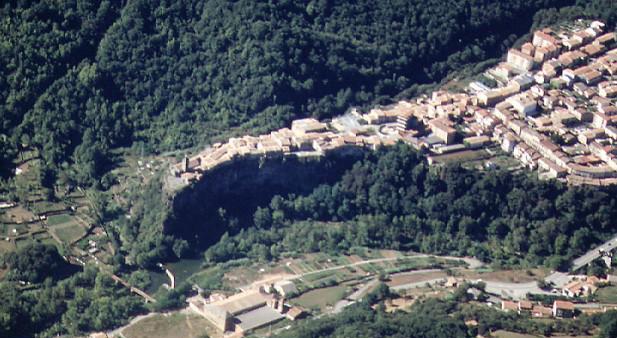
In the photo, we can see how the lava flow went down by the old Fluvià valley (form right to left in photo), giving rise to two different streams: the Turonell stream (top) and Fluvià River (down). In the picture below, we observed a schematic geological map of Castellfollit de la Roca. Of the three lava flows, only two formed the current basalt cliff.
En la foto, podem observar com la colada de lava, es va escolar per l'antiga vall del Fluvià (de dreta a esquerra a la foto), donant lloc a dos rieres diferents: la riera de Turonell (a dalt) i el riu Fluvià (a baix). En la imatge següent, podem observar un mapa geològic esquemàtic, de Castellfollit de la Roca. De les tres colades de lava, només dues, van formar l'actual cinglera basàltica.
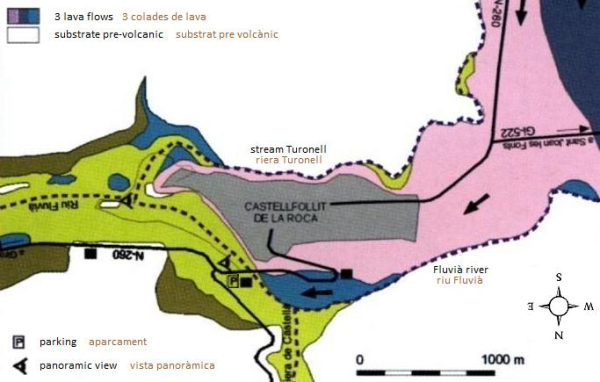



AGE OF MATERIALS AND PROCESSES REPRESENTED EDAT DELS MATERIALS I PROCESSOS REPRESENTATS
The volcanic materials were placed during the Quaternary, particularly during the Pliocene.
The erosion processes began during the Pliocene and the Holocene.
Els materials volcànics es van emplaçar durant el Quaternari, concretament durant el Pliocè.
Els processos erosius es van iniciar durant el Pliocè i l’Holocè.
GEOLOGICAL CONTEXTUALIZATION (SPACE/TIME) CONTEXTUALITZACIÓ GEOLÒGICA (ESPAI/TEMPS)
The basalt cliffs are the result of erosion, by Fluvià river and the stream of Turonell, on the volcanic remains of thousands of years.
This basalt cliffs formed by two overlapping lava flows:
- First lava flow, comes from volcanoes of Batet de la Serra (moved through the Fluvià valley, to Sant Jaume de Llierca), and has about 217,000 years old.
- Second lava flow, which covered the oldest lava, comes from volcanoes of Beguda - Sant Joan de les Fonts (moved through the Turonell valley), and has about 192,000 years old.
In the two lava flows, the differential cooling of the mass of magma created several levels inside.
Between the two lava flows, there is a small paleosòl formed by clay and piroclasts, as a consequence of the period of calm (of 25,000 years), there were between one and another lava flow. This accumulation of sedimentary material formed a deposit readily identifiable, clearly separating the two episodes.
The obstruction of watercourses (Fluvià and Turonell) was momentary, as the waters began an erosion, is localized at the boundary between the sedimentary rocks and basaltic materials.
Aquesta cinglera basàltica és la conseqüència de l'acció erosiva dels rius Fluvià i Turonell sobre les restes volcàniques de fa milers d'anys.
Aquesta cinglera de basalt està formada per la superposició de dues colades de lava:
- la Primera colada de lava, prové dels volcans de Batet de la Serra (va avançar per la vall del Fluvià, fins a Sant Jaume de Llierca), i té uns 217.000 anys d’antiguitat.
- la Segona colada de lava, que va recobrir la colada de lava més antiga, prové dels volcans de Begudà - Sant Joan les Fonts, (va avançar per la vall del Turonell), i té uns 192.000 anys d’antiguitat.
En ambdues colades de lava, el refredament diferencial de la massa de magma, creà diversos nivells en el seu interior.
Entre les dues colades hi ha un petit paleosòl, format per argiles i piroclasts, producte del període de calma de 25.000 anys, que va haver-hi entre una colada i l’altra colada de lava. Aquesta acumulació de materials sedimentaris, va formar un dipòsit fàcilment identificable, que separa clarament els dos episodis.
L'obstrucció dels cursos fluvials, del Fluvià i del Turonell, fou momentània, doncs les seves aigües van començar una acció erosiva, que es localitzà en el límit entre els materials basàltics i les roques sedimentàries.
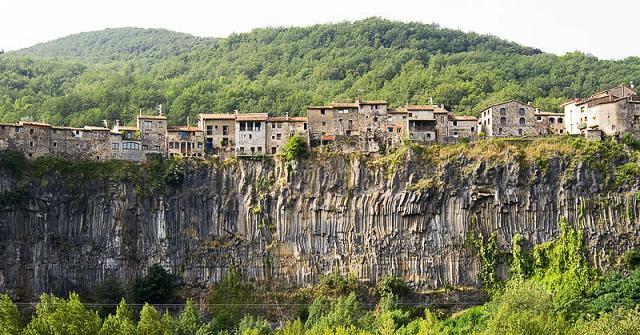
In this cliff you can see the prismatic disjunctions, basalt that form as it cools slowly and at rest (the solidified lava, resulting in a hard rock, basalt. In the process of cooling lava shrinks, cracks and takes different forms and habits of retraction).
The base of the cliff consists of sandstones and mudstones of the Eocene, above, there are gravel, composed of abundant pebbles of limestone, sandstone, and some exceptionally basalt. Fluvià and Turonell in a slow erosion process, have plowed their beds in the contacts between lava flows and the preexisting relief. This process has exposed at the base of the basalt cliff, an ancient river terrace on which were placed lava flows. At the base of the cliff, river vegetation grows with ash trees, poplars, alders and willows.
Above these materials, sit about 40 meters of basalt gray or black.
However, about 9 meters of the start of massive volcanic materials (approximately in a quarter of the base of the cliff), there is a level, with a thickness between 0.2 and 1.5 meters of clays and piroclasts (easily recognized because there is growing herbaceous vegetation). The presence of a paleosòl (ancient soil formed by alluvial and pyroclastic materials, lighter colors), explains that in this area were placed two lava flows, and indicates that between the emission of one and the another, spent enough time because the river sediment could all these materials.
This paleosòl divides the basaltic cliffs, into two units (upper and lower):
The lower unit has three distinct levels:
· The first level, with retraction of columnar habit, often covered by vegetation, has a thickness of 7 meters and is composed of prisms of about 50 centimeters in diameter.
· The second level shows a lenticular habit (slabs) and has a thickness of about 3.5 meters.
· The last level is formed again by columnar prisms, but in this case the thickness becomes a meter, and diameter of the columns is about 30 centimeters.
The upper unit has four levels:
· The first three, with a thickness of about 5 to 9 meters each, show a marked columnar disjunction.
· Above that, there is a level, with a thickness of 9 meters, with a bolar disjunction as a result of the alteration.
En aquesta cinglera es poden observar les disjuncions, en forma de prisma, que forma el basalt en refredar-se lentament i en repòs (la lava, en solidificar, dóna lloc a una roca de gran duresa, el basalt. En el procés de refredament, la lava es contrau, s'esquerda i pren diferents formes o hàbits de retracció).
La base del cingle està constituïda per gresos i margues de l’Eocè, i per sobre hi ha unes graves formades per abundants còdols de calcàries, gresos i, excepcionalment, algun de basalt. El Fluvià i el Turonell, en un lent procés erosiu, han solcat els seus llits en els contactes entre les colades de lava i el relleu preexistent. Aquest procés ha posat al descobert, a la base de les colades, una antiga terrassa fluvial sobre la qual es van emplaçar els corrents de lava. A la base de la cinglera, trobem vegetació de ribera amb freixes, pollancres, verns i salzes.
Per damunt d’aquest materials, s’assenten uns 40 metres de basalt de color gris o negre.
Tot i això, a uns 9 metres de l’inici dels materials volcànics massissos (aproximadament a un quart de la base del cingle), s’observa un nivell, amb un gruix entre 0,2 i 1,5 metres, d’argiles i piroclasts (es reconeix amb facilitat perquè hi creix abundant vegetació herbàcia). La presència d'un paleosòl (sòl antic format per materials al·luvials i piroclàstics, de colors més clars), permet explicar que en aquesta zona es van emplaçar dues colades, i indica que entre l'emissió d'una i de l'altra va passar prou temps perquè el riu pogués sedimentar tots aquests materials.
Aquest paleosòl divideix la cinglera basàltica en dues unitats (inferior i superior):
La unitat inferior presenta tres nivells ben diferenciats:
· El primer nivell amb hàbit de retracció columnar, sovint tapat per la vegetació de ribera, té un gruix de 7 metres i està format per prismes d’uns 50 centímetres de diàmetre.
· El segon nivell mostra un hàbit lenticular (lloses) i el seu gruix és d’uns 3,5 metres.
· El darrer nivell està format novament per prismes columnars, però en aquest cas el seu gruix no arriba a ser d'un metre, i el diàmetre de les columnes és d’uns 30 centímetres.
La unitat superior té quatre nivells:
· El tres primers, amb un gruix d'uns 5 a 9 metres cadascun, presenten una marcada disjunció columnar.
· A sobre d’aquests es troba un nivell, amb un gruix de 9 metres, amb una desenvolupada disjunció bolar com a conseqüència de la seva alteració.



THE BASALT QUARRY LA PEDRERA DE BASALT
In Castellfollit de la Roca, has the unique basalt quarry active throughout the country. Currently, and since 1929, is operated by the Ortiz family. The first news of the quarry, are the year 1887.
The basalt extracted, are given two basic applications: an industrial application (as an anti acid rock), and a decorative or domestic application (fireplaces, floors, statues...). A good example of the domestic utility, from the extracted basalt, is the pavement of the old town of Castellfollit de la Roca.
A Castellfollit hi ha la única pedrera de basalt activa de tot l'Estat. Actualment, i des de l'any 1929, és explotada per la família Ortiz. Les primeres notícies de la pedrera, són de l'any 1887.
Les aplicacions que es donen al basalt extret són, bàsicament, dues: una d'industrial (com a roca antiàcida) i una altra de domèstica i decorativa (llars de foc, paviments, estàtues,...). Un bon exemple de la utilitat domèstica, del basalt extret, és el paviment del barri vell del poble de Castellfollit de la Roca.
 Route number 13 "Castellfollit de la Roca cliffs": Itinerari núm 13 "Cingleres de Castellfollit de la Roca":
Route number 13 "Castellfollit de la Roca cliffs": Itinerari núm 13 "Cingleres de Castellfollit de la Roca":
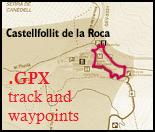 I encourage you to follow the pedestrian route number 13 "Castellfollit de la Roca cliffs" (2.16 Km - 35 minutes), so you can see in all its magnitude, this basalt cliffs and the beautiful village of Castellfollit de la Roca.
I encourage you to follow the pedestrian route number 13 "Castellfollit de la Roca cliffs" (2.16 Km - 35 minutes), so you can see in all its magnitude, this basalt cliffs and the beautiful village of Castellfollit de la Roca.
Clicking the image below, you can download the entire track of the route, and waypoints in GPX format.
Us animo a seguir l'itinerari pedestre número 13 "Cingleres de Castellfollit de la Roca" (2.16 Km - 35 minuts), del parc natural, per tal que pugueu observar amb tota la seva magnitud, aquesta cinglera basàltica, i el bell poble de Castellfollit de la Roca.
Clicant la següent imatge, us podreu baixar el track sencer de l'itinerari, i els waypoints, en format GPX.



To validate this EarthCache: Per validar aquest EarthCache:
1] By registering the cache, you can take a picture with your GPS in these coordinates, and upload it with your registration.
Al registrar el catxé, us podeu fer una fotografia amb el vostre GPS, en aquestes coordenades, i penjar-la amb el vostre registre.
2] To answer the following questions: Contestar les següents preguntes:
- At the end of the cliff, find the viewpoint-square Josep Pla. This balcony offers a spectacular panoramic view, and allows us to understand the strategic position of the village, and their natural qualities to the defense.
In the viewpoint, you'll see a grouping of fragments columnar (prismatic) basalt, nailed to the floor in a decorative fashion.
How many pieces comprise? Note well, the color, texture, and morphology of prismatic basalt!
Which of the two lava flows coming from? How to determine which lava flow, fragments belong?
Do not post photos of this group of fragments.
A l'extrem de la cinglera, trobem la plaça-mirador Josep Pla. Aquesta balconada ens ofereix una espectacular panoràmica i ens permet entendre la posició estratègica del poble i les seves qualitats naturals per a la defensa.
En el mirador, veureu una agrupació de fragments columnars (prismàtics) de basalt, clavats a terra, de forma decorativa.
Quants fragments en formen part? Observeu bé, el color, la textura, i la morfologia prismàtica del basalt!
De quina de les dues colades de lava procedeixen? Com determineu a quina colada de lava, pertanyen els fragments?
No publiqueu fotos d’aquesta agrupació de fragments.
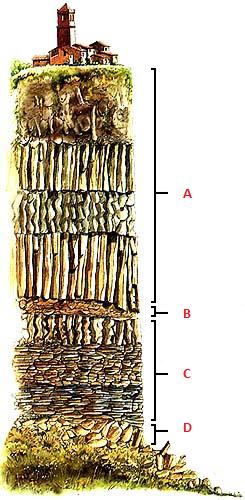
- What type of rock is Basalt? Describes it. Quin tipus de roca és el Basalt? Descriu-lo.
- In the following outline of the basalt cliffs, relate the letters (A...D) with all of the following concepts.
All of them are detailed in the description of Earthcache. Enjoy your visit to Castellfollit of the Rock, to capture the reality of these concepts.
· Lenticular or slabs habit
· Upper lava flow (second flow)
· Prismatic or columnar habit
· Fluvial terrace, before the lava flows
· Lower lava flow (first flow)
· Paleosòl (ancient soil)
En el següent esquema de la cinglera basàltica, relacioneu les lletres (A...D), amb tots els conceptes següents.
Tot ells estan detallats a la descripció del Earthcache. Aprofiteu la vostra visita a Castellfollit de la Roca, per plasmar a la realitat aquests conceptes.
· Hàbit lenticular o en lloses
· Colada de lava Superior (segona colada)
· Hàbit prismàtic o columnar
· Terrassa fluvial, anterior a les colades de lava
· Colada de lava Inferior (primera colada)
· Paleosòl (antic sòl)



You must send the answers (in Catalan, Spanish or English). You can log it without waiting to receive my validating response.
Heu d'enviar les respostes (en Català, Castellà o Anglès). No cal esperar la meva resposta per fer el registre online.
I hope you enjoy this beautiful place. Espero que gaudiu d'aquest paratge.
